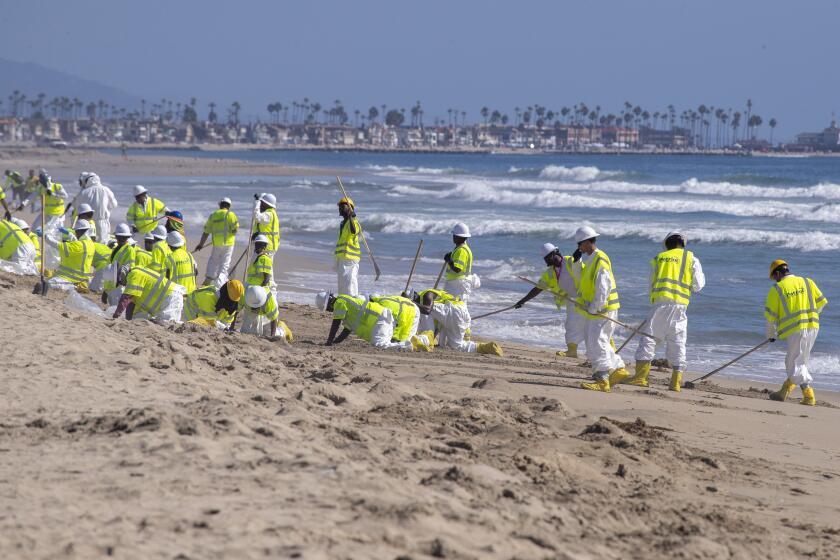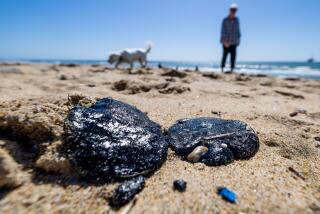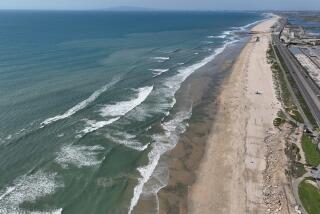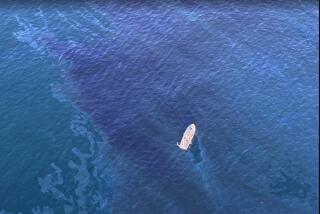Oil spill off Orange County coast is smaller than estimated, Coast Guard says
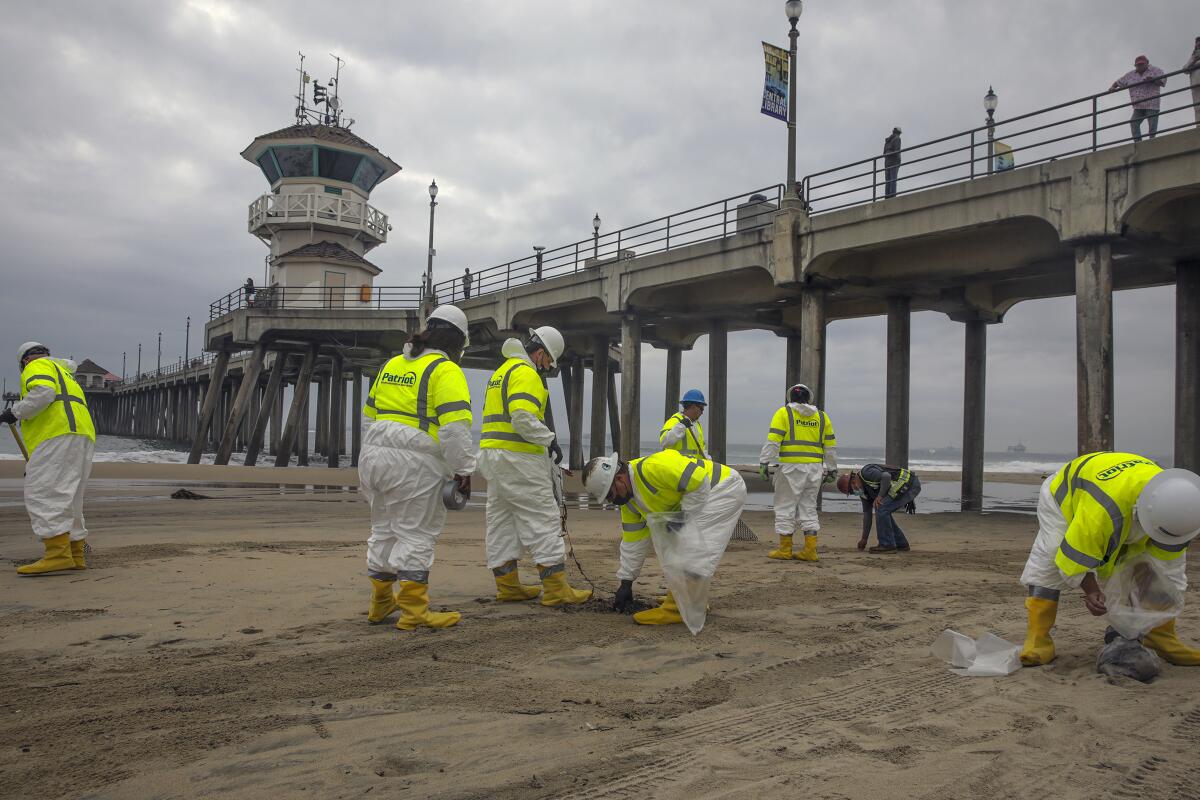
Officials say the amount of oil that leaked from a pipeline off the Orange County coast, fouling stretches of sand and threatening ecologically sensitive areas from Huntington Beach to San Diego County, may be smaller than originally projected.
In the first days of the spill, officials warned that possibly 126,000 gallons had flowed out of a pipeline that runs from the Port of Long Beach to an offshore production and processing platform. That number was raised on Monday to potentially 144,000 gallons.
However, Capt. Rebecca Ore, commander of the U.S. Coast Guard’s Los Angeles-Long Beach sector, said Thursday that after further assessments officials had determined that a minimum of about 24,696 gallons, or 588 barrels, and a maximum of 131,000 gallons, or 3,134 barrels, of oil was released from the pipeline.
A massive oil spill off the Orange County coast has fouled beaches and killed birds and marine life
The 131,000-gallon estimate is a “maximum worst-case discharge that is a planning scenario based on a volume in a pipeline,” Ore said.
Officials were unable to narrow that estimate, leaving another unanswered question as the mystery surrounding how the leak occurred continues to unfold.
“We’re nearly a week into this, and while our cleanup and our emergency response is well underway, we still don’t know answers to how this happened, why it happened and who is ultimately responsible,” Orange County Supervisor Katrina Foley said.
Coast Guard officials said Friday that damage to the pipeline could have occurred several months to nearly a year before the spill.
Investigators suspect an initial anchor strike from a large vessel displaced a portion of the pipeline 105 feet and stripped away its concrete casing, causing it to be more vulnerable to other possible anchor strikes or environmental stressors.
As they attempt to determine when that first strike occurred, investigators are focusing on a storm that brought strong winds to the area over the course of two days in late January, U.S. Coast Guard Capt. Jason Neubauer said during a press conference Friday afternoon.
He added that it’s still not clear when the pipe began leaking.
“It’s very possible that the initial strike just deflected the pipeline with no fracture and then additional stresses added later by another incident or geological events...either increased the fracture or caused the whole thing,” Neubauer said.
Cleanup efforts along the coast have accelerated through the week.
More than 900 people have been surveying beaches and clearing oil from Sunset Beach in Huntington Beach to San Diego County. By the end of the week, officials expect to ramp that number up to 1,500.
Officials said they’ve made progress in the cleanup and hope to advance further over the weekend. But a storm that meteorologists say could bring winds gusting up to 23 mph began moving in Friday afternoon, raising concerns that more oil could reach the shore. Similar wind speeds are expected Monday and Tuesday, meteorologists with the National Weather Service in San Diego said.
So far, much of the crude has remained offshore, but striations have been seen in Huntington Beach, Newport Beach and Laguna Beach. The beaches and water that have been fouled by the spill in Orange County are on the ancestral homelands of the Acjachemen and Tongva people. Stretches of sand in Huntington Beach and parts of Newport Beach have been the most severely affected.
Tar balls that officials suspect came from the oil spill have also washed up in Oceanside, Carlsbad, Encinitas and Del Mar in San Diego County over the last day. Images from satellites over the oil spill Friday morning show some oil nearing the coast in Newport Beach, Laguna Beach and San Clemente.
Loren Sibrian thought it was strange that no one was swimming or walking along the shore in Huntington Beach as she made her way onto the sand Friday afternoon.
The 37-year-old Anaheim resident pulled out her phone and Googled, “Why is the beach closed?” It was then that Sibrian, who described herself as “not much of a news person,” learned about the spill that has sullied the beaches along the Orange County coast for the last week.
“What a bummer,” she recalled thinking. Still, she unfurled her purple blanket just behind the caution tape and laid down in the sand to read a book.
“You can still enjoy it,” she said looking out at the waves, “but not quite as close.”
A pollution-control vessel has been working off the Huntington Beach coast, where a plume of oil has lingered since the spill. Three other vessels were tackling another slick that has slowly moved south and is now off the coast of San Clemente. A fourth vessel was working along the coast of Corona del Mar, maps show.
More than 5,500 gallons of crude oil have been recovered off the coast. Roughly 172,500 pounds of oily debris has been collected from shorelines since the spill and 13 barrels of tar balls were recovered Thursday. Coast Guard officials have deployed 14,060 feet of containment booms in an effort to contain the spill.
One of the long, white booms snaked across the water at Talbert Marsh on Friday morning. Cleanup crews that had swarmed the 25-acre marsh over the last week had moved on, but a woman in a neon yellow vest and rain boots walked slowly along the water line. She bent down, running her fingers over a stubby, ground-covering plant blanketing the marsh. She nodded.
“Looking good,” she said.
Crews are also surveying the coast in search of wildlife disturbed by the spill. As of late Thursday, they had recovered 25 live oiled birds: seven western grebes, seven snowy plovers, three sanderlings, an eared grebe, an American coot, a ruddy duck, a double-crested cormorant, a Clark’s grebe, a California gull, a western gull and a brown pelican.
Three double-crested cormorants, three Brandt’s cormorants, an American coot, a black-crowned night heron, a red-footed booby and a western gull were found dead, according to the Oiled Wildlife Care Network.
It’s unclear how long it will take for the beaches to be cleaned and the water to reopen. Some officials have estimated it could take weeks. The spill has prompted increasing calls from environmentalists and some lawmakers to end offshore oil drilling in the region.
Gabriel Vargas stood along Pacific Coast Highway in Huntington Beach late Friday morning holding one end of a long banner that read “END OFFSHORE DRILLING.”
Vargas, an underwater cinematographer, said although he can’t go into the water right now, he’s spent the last few days gathering film of cleanup efforts. He may eventually make a short documentary about the oil spill, he said.
His partner, Bronwyn Major, who works as a surf coach, said she hopes the spill will serve as a catalyst for change. It’s past time to turn away from subsidizing big oil companies and move toward clean technology, she said.
“We’re in the middle of a climate crisis,” she said. “I’ve had it. Enough is enough.”
Along the shoreline, a small team of workers in white hazmat suits and helmets paced back and forth surveying the stretch of sand along Pacific Coast Highway. Some took notes. One worker pointed at the backlog of cargo ships waiting to enter port lined up on the horizon. Another cleanup crew — dressed in yellow vests and holding rakes and shovels — stood in a nearby parking lot waiting to be deployed. A newcomer to the crew asked those around her for tips.
“What does the oil look like?” she asked.
“Little black balls,” another responded.
“Just like tar?”
“Exactly.”
She nodded, gripping her rake, ready to begin. “Let’s do this,” she said.
San Diego Union-Tribune staff writer Joshua Emerson Smith contributed to this report
More to Read
Sign up for Essential California
The most important California stories and recommendations in your inbox every morning.
You may occasionally receive promotional content from the Los Angeles Times.
